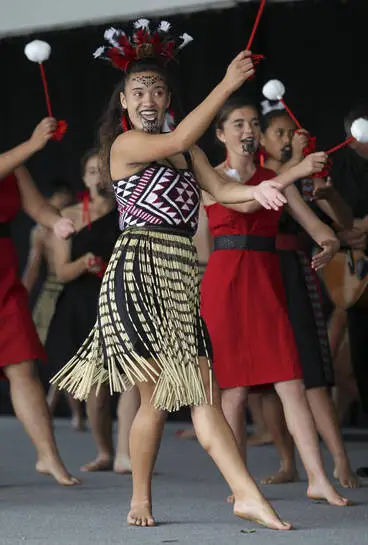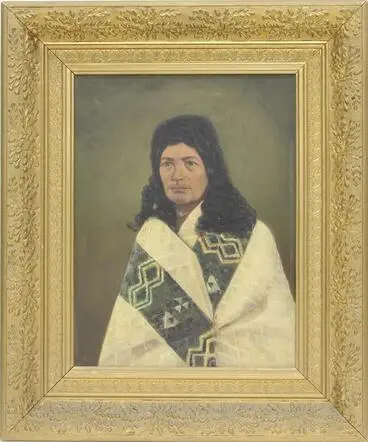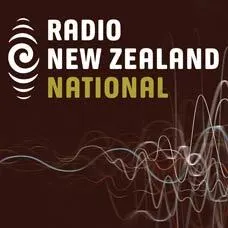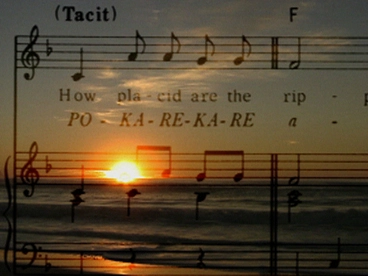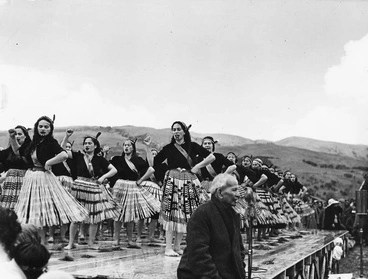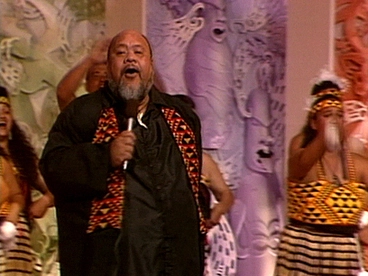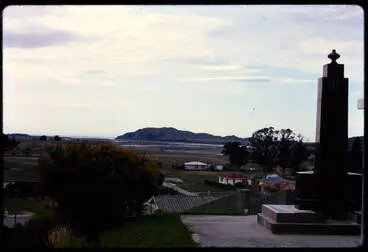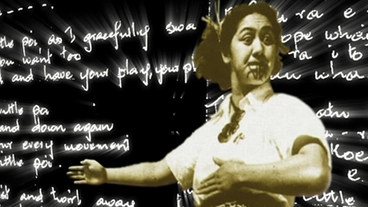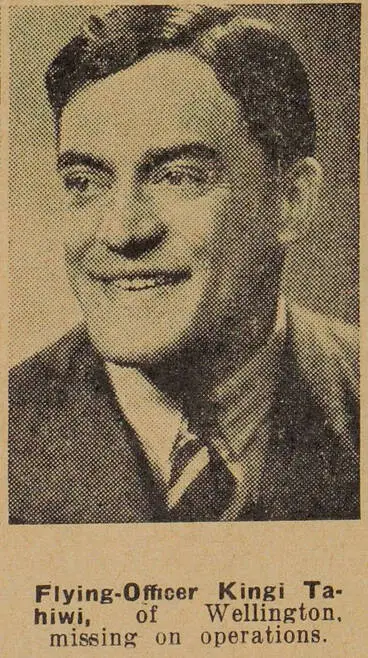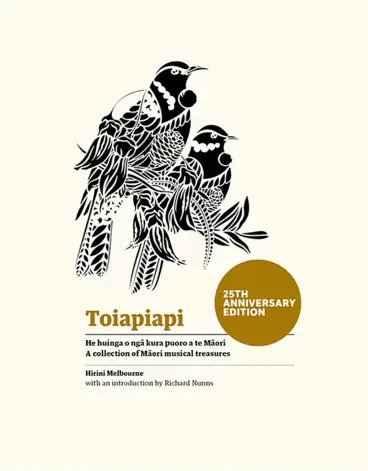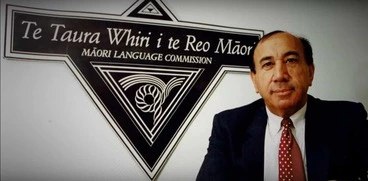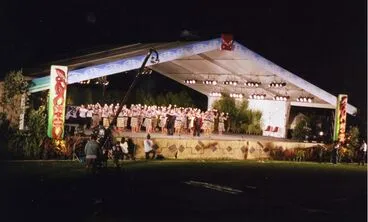Māori Composers of Waiata and Haka
A DigitalNZ Story by National Library Services to Schools
This story provides links to resources about some of Aotearoa New Zealand's Māori composers of waiata and haka.
Kapa Haka performance, ASB Polyfest 2015.
Auckland Libraries
INTRODUCTION
From early creators of traditional mōteatea (chanted song-poetry) to contemporary composers who draw on introduced musical styles and influences, the Māori world has been home to many important composers.
Māori composers have created traditional music forms and music drawing on both Māori and European styles and influences.
Source: Māori composers - ngā kaitito waiata, Te Ara — the Encyclopedia of New Zealand
Annual coronation hui, Turangawaewae Marae, Ngaruawahia
Alexander Turnbull Library
TRADITIONS OF COMPOSING
Mōteatea is a centuries-old tradition of chanted song-poetry. Mōteatea were composed for many purposes and reasons, and their composers were great poets. Chiefs and leaders were often composers who used music as an important way to communicate ideas.
Traditional composers sometimes composed chants to call on gods or spirits. Gods and ancestors could express themselves in the world through music and the human voice.
EARLY TRADITIONAL COMPOSERS
- Mananui Te Heuheu, the paramount chief of Ngāti Tūwharetoa, composed a famous waiata tangi (lament) for his younger brother, Pāpaka Te Naeroa, who died in battle.
- Te Rangitopeora of Ngāti Toarangatira wrote songs about her many marriages and romances.
- Mihi-ki-te-kapua was a renowned composer from Ngāti Ruapani and Tūhoe. Her best-known waiata, ‘Taku rākau e’, is still sung by people throughout New Zealand.
Source: Māori composers - ngā kaitito waiata, Te Ara — the Encyclopedia of New Zealand
Māori literature in print
Manatū Taonga, the Ministry for Culture and Heritage
MANANUI TE HEUHEU TŪKINO II (NGĀTI TŪWHARETOA)
ĒNOKA TE PAKARU (TE AITANGA-A-MĀHAKI)
Ēnoka Te Pakaru
Hiruharama Maori School : [Songs] [sung by children of Hiruharama Maori School]
Alexander Turnbull Library
Enoka Te Pakaru
Manatū Taonga, the Ministry for Culture and Heritage
TE RONGITOPEORA (NGĀTI TOA)
Richards, Edward Smallwood, 1834-1917 :Portrait of Te Rangi Topeora
Alexander Turnbull Library
Te Rangitopeora by Gottfried Lindauer
Manatū Taonga, the Ministry for Culture and Heritage
Te Rangitopeora
DigitalNZ
MIHI-KI-TE-KAPUA (NGĀI TŪHOE)
Mihi-ki-te-kapua
Manatū Taonga, the Ministry for Culture and Heritage
TE RANGI PAI/FANNY ROSE HOWIE
Concert party including Princess Te Rangi Pai
Alexander Turnbull Library
Te Rangi Pai recital, 1906
Manatū Taonga, the Ministry for Culture and Heritage
PARAIRE HENARE TOMOANA (NGĀTI KAHUNGUNU)
LATER COMPOSERS
From the late 19th century Māori concert parties travelled to Māori villages to perform. The visits aimed to encourage tribal identity and sometimes to raise funds for community projects. These included the revival of East Coast marae (led by Apirana Ngata) and setting up Tūrangawaewae marae in Ngāruawāhia (led by Te Puea Hērangi).
- Paraire Tomoana composed songs in the new ‘action song’ style, which often drew on European melodies. His songs include the famous ‘Pōkarekare ana’.
- Tuini Ngāwai was an important East Coast composer who wrote many songs, including ‘Arohaina mai e te Kīngi nui’, which became an unofficial anthem for the Māori Battalion during the Second World War.
- Ngoi Pēwhairangi’s songs included ‘E ipo’, made famous by Prince Tui Teka, and ‘Poi e’, a hit for the Pātea Māori Club.
- Hirini Melbourne composed many songs for schools, including ‘Pūrea nei’ and ‘Tihore mai’. He played an important part in reviving the use of taonga puoro (traditional musical instruments).
- Gillian Karawe Whitehead trained in the European classical music tradition and later began using taonga puoro and the Māori language in her music.
Source: Māori composers - ngā kaitito waiata, Te Ara — the Encyclopedia of New Zealand.
Waiata for Victoria Cross winner at Ruatoria, 1943
Manatū Taonga, the Ministry for Culture and Heritage
PUHIWAHINE (NGĀTI TŪWHARETOA)
Puhiwahine
Manatū Taonga, the Ministry for Culture and Heritage
TUINI NGĀWAI (NGĀTI POROU)
Ngāti Porou songwriter of genius, Tuini Ngāwai
Manatū Taonga, the Ministry for Culture and Heritage
Tuini Ngāwai
Manatū Taonga, the Ministry for Culture and Heritage
Tuini Ngāwai and Ngoi Pēwhairangi, 1943
Manatū Taonga, the Ministry for Culture and Heritage
NGOI PĒWHAIRANGI (NGĀTI POROU)
Ngoi Pēwhairangi, 'Whakarongo'
Manatū Taonga, the Ministry for Culture and Heritage
Dalvanius
NZ On Screen
SIR APIRANA NGATA (NGĀTI POROU)
Sir Āpirana Ngata
Manatū Taonga, the Ministry for Culture and Heritage
Sir Apirana Ngata leading a haka at the Centennial celebrations at Waitangi last week. (Evening Post, 12 February 1940)
National Library of New Zealand
Memorial to Sir Apirana Ngata, Tikitiki
Auckland Libraries
KOHINE TE WHAKARUA PONIKA (NGĀI TŪHOE)
KĪNGI TĀHIWI (NGĀTI RAUKAWA)
George Nepia and Kingi Te Ahoaho Tahiwi
Alexander Turnbull Library
Flying-Officer Kingi Tahiwi, of Wellington, missing on operations
Auckland Libraries
HIRINI MELBOURNE (NGĀI TŪHOE)
Hirini Melbourne and Richard Nunns
Alexander Turnbull Library
Hirini Melbourne
Manatū Taonga, the Ministry for Culture and Heritage
NGĀPŌ WEHI (NGĀI TŪHOE, TE WHAKATŌHEA, NGĀPUHI, TE WHĀNAU A APANUI, NGĀTI KAHU) AND PIMIA WEHI
TĪMOTI KĀRETU (NGĀI TŪHOE, NGĀTI KAHUNGUNU)
Dr Timoti Karetu - Ngā Tāonga Kōrero
Radio New Zealand
SIR KĪNGI IHAKA (TE AUPŌURI)
Hongi during the investiture of Archdeacon Sir Kingi Ihaka - Photograph taken by Ross Giblin
Alexander Turnbull Library
Sir Kingi Ihaka - Photograph taken by Phil Reid
Alexander Turnbull Library
Māori broadcaster Kingi Ihaka dies
Radio New Zealand
SIR DEREK LARDELLI (NGĀTI POROU, RONGOWHAKAATA, NGĀTI KONOHI, NGĀTI KAIPOHO)
KINGI KIRIONA (TAINUI)
Mana Tangata: Kingi Kiriona
Radio New Zealand
Kingi Kiriona - Hip hop haka
Radio New Zealand
WETINI MĪTAI-NGĀTAI (TE ARAWA)
Wetini Mītai-Ngātai
Kapa haka expert deems England's 'flying V' a good way of retaliating to challenge
Radio New Zealand
Performers, Aotearoa Traditional Māori Performing Arts Festival
Upper Hutt City Library
Te Matatini festival - Kapa Haka
Palmerston North City Library
Aotearoa Traditional Māori Performing Arts Festival performers
Upper Hutt City Library
Kapahaka - the pinnacle of Māori performing arts
Radio New Zealand
This story was curated and compiled by Te Puna Mātauranga o Aotearoa | National Library of New Zealand, Services to Schools staff, November 2020.
